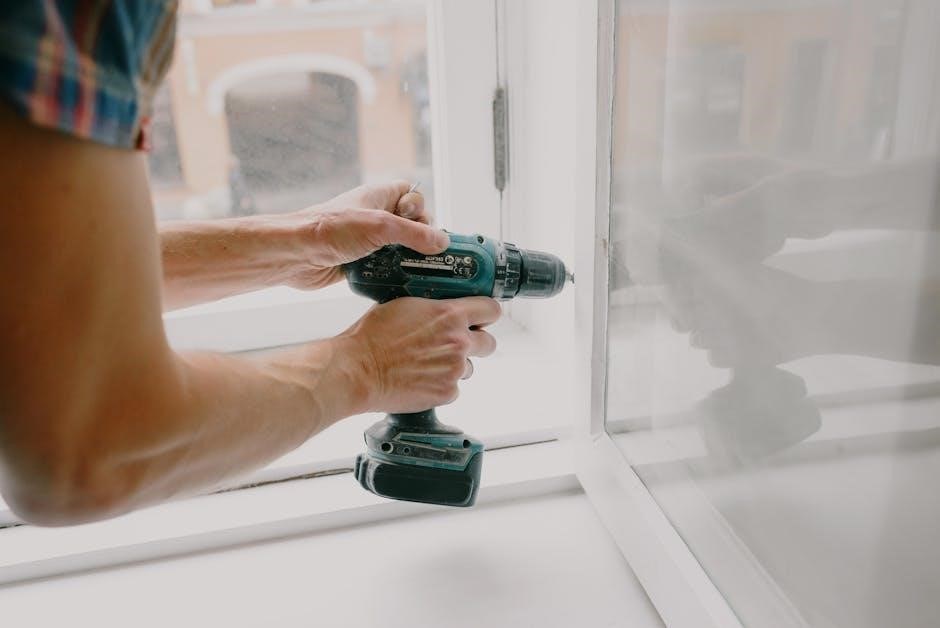Power windows are a convenient feature in modern cars, but when they fail, it can be a major inconvenience. This guide provides a step-by-step solution to manually roll up a stuck power window, ensuring safety and convenience until professional repair is possible. Learn how to address the issue using basic tools and precautions.
Overview of the Problem
Power windows can stop working due to a dead battery, faulty motor, or broken regulator, leaving the window stuck. This issue can expose your car to weather and security risks. Manually rolling up the window is a practical solution until professional repair. The process involves removing the door panel, accessing the regulator, and using basic tools to secure the window. This guide provides a clear, step-by-step approach to address the problem safely and effectively, ensuring your car remains protected while you await a permanent fix.
Importance of Knowing How to Manually Roll Up a Power Window
Knowing how to manually roll up a power window is essential for preventing water damage, theft, and further mechanical issues. A stuck window can leave your car vulnerable to weather and unauthorized access. By learning this skill, you can protect your vehicle’s interior and maintain security until professional repairs are made. This knowledge also saves time and money, avoiding costly labor fees. It’s a practical skill that ensures convenience and peace of mind, especially during unexpected electrical or mechanical failures.

Understanding the Components of a Power Window System
A power window system consists of a motor, regulator, and switch. The motor drives the window, the regulator guides it, and the switch controls the motor’s direction.
Motor and Regulator Mechanism
The motor powers the window’s movement, while the regulator, a cable-and-pulley system, guides it up and down. Together, they ensure smooth operation. If the motor fails, the regulator can be manually adjusted to move the window. Understanding this mechanism is crucial for manual operation, allowing you to bypass the motor and directly manipulate the regulator to raise the window when the power system fails.
Role of the Switch in Power Window Operation
The switch is the control point for the power window system, sending electrical signals to the motor to determine the direction and speed of the window’s movement. When you press the switch, it activates the motor, which then drives the regulator to move the window up or down. A faulty switch can disrupt communication between the motor and the system, causing the window to malfunction; Understanding the switch’s role is essential for diagnosing issues and manually operating the window when the electrical system fails.

Safety Precautions
Disconnect the car battery to prevent accidental electrical shocks or unexpected motor activation. This step is crucial for ensuring safety while manually rolling up the power window.
Disconnecting the Car Battery
Disconnecting the car battery is a critical safety step before manually rolling up a power window. This prevents accidental electrical shocks or unexpected motor activation. Locate the battery, typically in the engine compartment, and identify the negative (black) and positive (red) terminals. Use a wrench or pliers to loosen the nut on the negative terminal clamp. Carefully lift the clamp off the terminal and set it aside. This ensures the power window system is completely deactivated. Always consult your vehicle’s owner’s manual for specific instructions, as battery locations and procedures may vary. Safety should never be compromised during this process.
Preventing Accidental Electrical Shocks
Preventing accidental electrical shocks is essential when working on a power window system. Always disconnect the car battery before starting the process to ensure no power flows to the window motor. Wear insulated gloves to protect yourself from potential electrical discharge. Ensure the vehicle is in park and the ignition is off to avoid any unexpected movements. Never touch electrical components with bare hands, as even a disconnected battery can retain residual power. By taking these precautions, you minimize the risk of injury and create a safer working environment for manually rolling up the window.

Necessary Tools and Materials
The essential tools include a screwdriver, wrench, and pliers for dismantling components. Additional materials like duct tape or adhesive strips can secure the window temporarily.
Basic Tools Required
To manually roll up a power window, you’ll need a few basic tools. A screwdriver (both Phillips and flathead) is essential for removing door panels and accessing internal mechanisms. Pliers or wrenches may be necessary to loosen clamps or bolts securing the window or regulator. A Torx bit set can be helpful if your vehicle uses Torx screws. Additionally, an Allen wrench might be needed for specific bolts. These tools are typically found in most households or basic toolkits, making the process accessible without specialized equipment. Ensure all tools are in good condition to avoid stripping screws or causing further damage.
Additional Materials for Securing the Window
Once the window is manually raised, securing it in place is crucial to prevent it from falling or allowing weather elements inside. Duct tape is a common solution, as it can hold the window firmly in its closed position. Weatherproof tape or strong adhesive strips can also be used for added security. If the window is shattered or broken, covering the opening with cardboard or plastic sheeting can protect the interior. These materials provide a temporary fix until professional repairs are made. Ensure the window is as stable as possible to avoid further damage or safety risks.

Step-by-Step Guide to Manually Rolling Up a Power Window
Disconnect the battery, remove the door panel, access the regulator, detach the glass, manually raise the window, and secure it in place using duct tape or clamps.
Disconnecting the Battery and Preparing the Vehicle
Start by disconnecting the car battery to prevent electrical shocks or unexpected motor activation. Locate the negative terminal, loosen the bolt, and pull the cable off. Ensure the vehicle is in park and all doors are closed. Turn the ignition to the “OFF” position to disable any power reserves. This step is crucial for safety, as it eliminates the risk of the window moving unexpectedly during manual operation; With the power cut off, you can safely proceed to remove the door panel and access the window regulator mechanism without worrying about electrical hazards.
Removing the Door Panel
To access the window regulator, start by removing the door panel. Use a screwdriver or wrench to remove the bolts or screws around the panel’s edges. Gently pry the panel away from the door frame, taking care not to damage the clips or wiring. Disconnect any electrical connectors for speakers, switches, or lights. Once the panel is removed, you’ll have clear access to the window regulator and motor. This step is essential for manually raising the window and ensuring the vehicle’s interior remains secure until professional repair.
Accessing the Window Regulator
After removing the door panel, locate the window regulator, which is typically attached to the door frame. You may need to remove additional screws or clips to access it fully. Gently pull the regulator away from the door to expose the mechanism. Be careful not to damage any cables or pulleys. If the window glass is still attached, you may need to detach it by loosening the bolts that hold it in place. This step allows you to manually operate the regulator and raise the window. Ensure the area is clear and handle the glass with care to avoid breakage.
Detaching the Glass from the Regulator
To detach the glass from the regulator, locate the bolts or clips holding it in place. Loosen these bolts using a wrench or screwdriver, but do not remove them completely. Carefully slide the glass up and out of the window opening, ensuring it is free from the regulator’s grip. Once detached, secure the glass with tape or a helper to prevent it from falling. This step allows you to manually raise the window without the glass obstructing the process. Handle the glass with care to avoid breakage and ensure the area is clear of debris.

Manually Raising the Window
After detaching the glass, use a wrench or pliers to manually turn the regulator mechanism, allowing the window to rise slowly. Ensure the area is clear of obstructions and the glass is securely held. Be patient and cautious to prevent damage. If the regulator is damaged, further disassembly may be necessary; For easier turning, a drill with a socket adapter can be used. This step requires attention to detail and careful execution to ensure the window is properly aligned and secured in place.
Securing the Window in Place
Once the window is manually raised, secure it immediately to prevent it from falling. Use strong duct tape to hold the window firmly in place, ensuring it’s aligned with the window frame. For added stability, apply additional strips of tape across the glass to the door or surrounding area. If available, use a temporary adhesive or clamps to reinforce the hold. Covering the window opening with plastic or cardboard can protect the interior from weather. This solution is temporary but effective until professional repair is possible. Always prioritize safety to avoid further damage or potential injury.

Common Issues and Solutions
Stuck windows and broken regulators are common issues. Solutions include manually raising the window, using duct tape for temporary securing, or addressing electrical or mechanical faults promptly.
Dealing with a Stuck Window
A stuck power window can be resolved by disconnecting the battery to prevent electrical shocks. Remove the door panel to access the regulator mechanism. Loosen the clamps holding the glass to the regulator, then manually push the window up. Secure it with duct tape temporarily. If the window is stuck due to debris or dirt, clean the track and apply silicone spray for smoother movement. In cases where the motor or regulator is faulty, professional repair may be necessary. Always prioritize safety and use proper tools to avoid further damage or injury.
Addressing a Broken Regulator
A broken regulator can prevent the window from moving, requiring manual intervention. Disconnect the battery to ensure safety. Use a drill to manually turn the regulator’s gears, allowing the window to move. If the regulator is severely damaged, remove it and lift the window glass carefully. Secure the glass in place using duct tape or temporary brackets. This solution provides a temporary fix until a professional can replace the regulator. Always handle the glass with care to avoid breakage and ensure the vehicle is secure from the elements.
Alternative Methods for Raising the Window
Alternative methods include using a drill to manually turn the regulator or directly supplying power to the motor. These approaches provide temporary solutions until professional repair is possible.
Using a Drill to Turn the Regulator
Attach a drill bit to the regulator’s manual override. Slowly drill clockwise to raise the window. Be cautious not to apply too much pressure, as the glass may break. Once the window is up, secure it with tape or a temporary fastener. This method bypasses the motor, allowing manual control. Ensure the battery is disconnected to prevent electrical issues. While effective, this is a temporary fix until professional repair. Always prioritize safety to avoid injury or further damage to the window or mechanism.
Supplying Power Directly to the Motor
Connect the window motor directly to a power source, such as a battery or jumper cables, to bypass the switch. With the ignition in accessory mode, carefully apply power to the motor terminals. The window should move upward. Use caution to avoid electrical shocks or sudden movements. This method is effective if the motor is functional but the switch or wiring is faulty. Once the window is up, disconnect the power source and secure the window temporarily. While this provides a quick fix, professional repair is still necessary to restore full functionality and safety.

Temporary Solutions Until Professional Repair
Secure the window with duct tape or a temporary cover to protect your car from weather and potential theft until professional repair is possible. This ensures safety and prevents further damage.
Using Duct Tape to Hold the Window Up
If your power window is stuck, duct tape can serve as a temporary solution to keep it in place. After manually raising the window as much as possible, apply sturdy duct tape across the top edge of the glass, pressing it firmly onto the door frame. This will hold the window securely until professional repair. While not a permanent fix, this method protects your car’s interior from weather and potential theft. Ensure the tape is applied tightly to avoid loosening over time. This simple solution buys you time until a proper repair can be made.
Covering the Window Opening
Covering the window opening is a practical temporary solution to protect your car’s interior when a power window won’t close. Use a sturdy plastic cover or tarp, securing it with strong adhesive tape around the door frame. Ensure the cover fits tightly to prevent weather damage or debris entry. For added security, apply additional layers of tape at the edges. This method is especially useful if the window is fully down and cannot be raised manually. While not a permanent fix, it effectively safeguards your vehicle until professional repairs are made. Regularly inspect the cover to ensure it remains secure.

Preventive Maintenance Tips
Regularly lubricate moving parts and inspect the window track and regulator to ensure smooth operation. Addressing issues early prevents mechanical failures and extends the system’s lifespan.
Regular Lubrication of Moving Parts
Regular lubrication of the window regulator, track, and other moving components is essential to maintain smooth operation. Use a silicone-based spray or grease to reduce friction and prevent corrosion. Avoid using WD-40, as it can attract dust and dirt, leading to premature wear. Lubricate the parts every 6-12 months or when you notice stiffness. This simple maintenance step can prevent mechanical failures and ensure your power window system operates efficiently. By keeping the components well-lubricated, you can avoid costly repairs and extend the lifespan of your car’s power window system.
Inspecting the Window Track and Regulator
Regularly inspecting the window track and regulator is crucial for maintaining smooth operation. Check for dirt, debris, or rust that may obstruct movement. Clean the track with a soft brush or cloth and apply silicone-based lubricant to keep it running smoothly. Examine the regulator for signs of wear, such as frayed cables or misaligned gears. If you notice any damage, address it promptly to prevent further issues. Proper inspection and maintenance can help extend the lifespan of your power window system and ensure reliable performance. Regular checks can also help identify potential problems before they escalate.
Manually rolling up a power window is a valuable skill for car owners, offering a practical solution during emergencies. It empowers drivers to handle unexpected situations safely and effectively, ensuring their vehicle remains secure until professional repairs can be made.
Manually rolling up a power window involves several key steps: disconnecting the battery for safety, removing the door panel to access the regulator, and detaching the glass from the mechanism. Once the glass is free, it can be manually pushed up and secured in place using temporary solutions like duct tape. Alternative methods include using a drill to turn the regulator or supplying power directly to the motor. These steps provide a practical solution to close the window until professional repairs are made, ensuring the vehicle remains secure and protected from the elements.
Final Tips for Car Owners
Regular maintenance is key to preventing power window issues. Lubricate moving parts and inspect the window track and regulator for wear. If a window becomes stuck, stay calm and follow safety precautions to avoid injury. Temporary solutions like duct tape or covering the window can protect your car until repairs are made. For a permanent fix, consider consulting a professional mechanic. By understanding the components and following these tips, you can address power window problems effectively and ensure your vehicle remains secure and functional.

